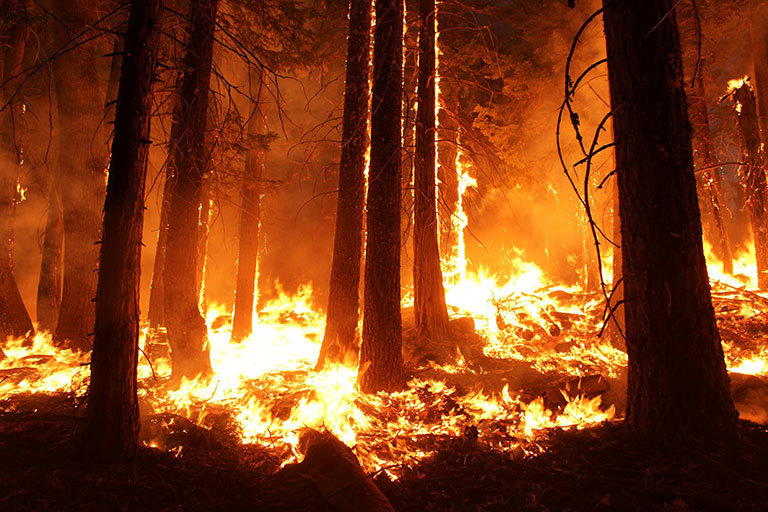The Science of Predicting Fires
By Rebekah Heath

The 2013 Rim fire in and near Yosemite National Park, California. Credit: Mike McMillan/USFS.
On the tails of the destructive California wildfires of this year, the 2017 Conference on Fire Prediction Across Scales is scheduled to take place October 23-25 at Columbia University. Globally, fires play an important role in climate change, as they emit both aerosols and greenhouse gases into the atmosphere at accelerated rates. Though fire is crucial for the renewal of many ecosystems, it can be extremely devastating for human life. The conference will focus on fire prediction through models that can be used as part of successful fire-management practices and for a gained understanding of past and future fire activity. Kátia Fernandes, an associate research scientist at the International Research Institute for Climate and Society, assisted in the planning and development of this year’s conference. Andrew Robertson, a senior research scientist and the head of IRI’s Climate Group, will be speaking and presenting during the conference. In this Q&A, Fernandes and Robertson explain more about the conference.
Tell us about this event. What role did you play in organizing this conference?
Fernandes: The organization of this event started a year ago and is part of the Columbia University Initiative on Extreme Weather and Climate. My co-organizers Robert Field from the NASA Goddard Institute for Space Studies, Park Williams from the Lamont-Doherty Earth Observatory and the Earth Institute’s Jaclyn Rabinowitz bring different perspectives to meeting. My experience working in tropical environments helped shape some of the sessions to address the natural and anthropogenic drivers and impacts of fires in tropical rainforests.
Why have this conference now?
Fernandes: The complex interactions among fire, climate, vegetation and humans, and the differing timescales over which various factors are important, make it challenging to determine how the evolution of these variables and related feedbacks will impact overall fire activity in a changing climate. The uncertainty we have in future changes to fire activity amplifies the uncertainty in the corresponding impacts on ecological and socio-economic systems. For the purposes of better constraining these types of projections, alongside operational fire management concerns, our goal is to identify the state of the art in fire prediction and a future research roadmap, and it is extremely important that both fire modelers and fire managers are participants in this process, and that we draw on outside expertise, from, for example, the weather forecasting and climate prediction communities.
What will you be discussing during your talk at the conference?
Robertson: I will discuss current and emerging capabilities in predicting climate on seasonal and subseasonal timescale, from two weeks to several seasons in advance. The IRI and other centers have been issuing seasonal climate predictions routinely since the late 1990s, but prediction on the subseasonal range – which fills the gap between weather forecasts and seasonal forecasts — is an emerging area of research. This timescale could be particularly relevant to fire risk early warning and prevention, giving managers forecasts on a range of timescales in a “seamless” way, from several seasons ahead, down to a few days ahead. Shorter-range weather forecasts can provide more specific information on the timing and location of fire weather, while the forecasts at longer subseasonal and seasonal ranges can help fire managers gauge likely fire risk that comes from a larger set of conditions playing out over longer time frames. I will introduce a new project of the World Weather and World Climate Research Programs specifically targeting research in the subseasonal-to-seasonal range that aims to fill this gap.
What can we use fire forecast information for?
Fernandes: It depends on the time and spatial scale of interest. For example, once a fire has started, weather forecasts can be used to predict its spread and intensity. That is crucial information for planning fire fighting efforts in the short-term. At the seasonal scale, fire prediction can be used to prevent fires from occurring by enacting rules reducing the number of agricultural fire permits issued, as in the case of Amazonian states, or directing fire brigades to high risk areas.
How have forecasts of fires and their impacts improved?
Fernandes: Realistic models of fire activity and behavior are necessary for operational fire management, and to understand past and future changes in fire activity. Such models take into account vegetation cover, land use practices, fire management capacity, extreme weather and climate variability but do not necessarily integrate all components. To foster knowledge exchange among the diverse fields of expertise involved in fire prediction and help us address this question is one of the main objectives of our conference.

You must be logged in to post a comment.